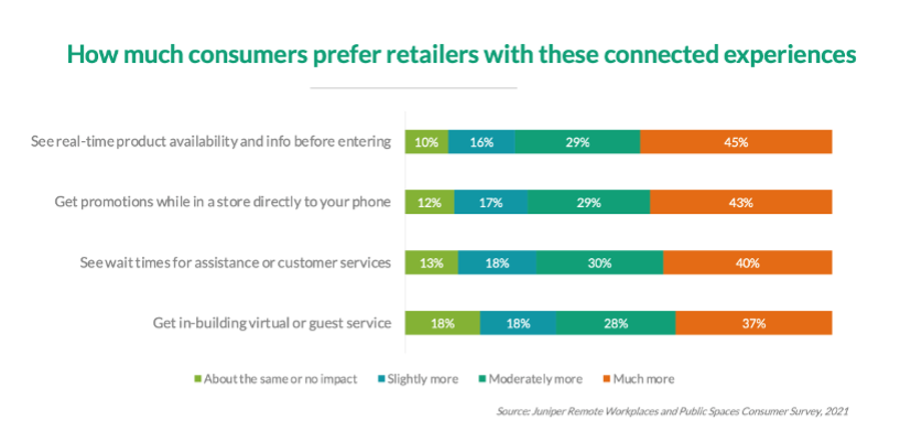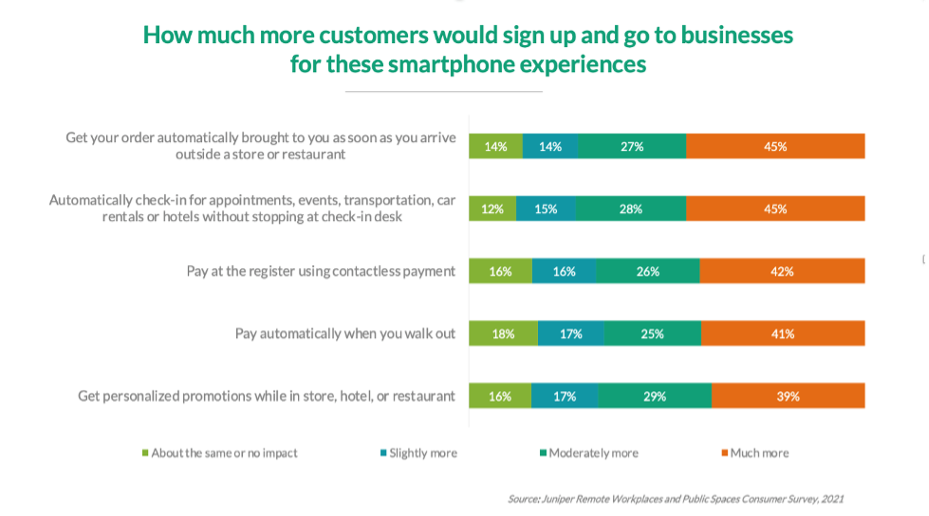The elements of the retail customer experience and how retailers can deliver the experiences customers want
For today’s retailers, delivering an exceptional customer experience has never been more challenging to achieve. Retailers need to leverage technology to embrace new consumer habits and shopping styles that meet new consumer demands. To drive consumers back into physical stores, they must also meet consumers’ in-store expectations with enhanced and personalized experiences and an interactive physical shopping journey. Location-based services and technologies can help retailers do just that.
In 2021, Juniper Networks sought to understand the demand for new retail customer experiences and how large retailers are investing in IT infrastructure in response to changes in demand. After all, 2020 and the pandemic’s challenges brought seismic changes in the business of retail.
Thus, we conducted two surveys, the Juniper Workplaces and Public Spaces Enterprise IT Survey and the Juniper Remote Workplaces and Public Spaces Consumer Survey.
The surveys showed us that 95 percent of customers and 78 percent of retailers value new, connected retail-customer experiences that will provide a faster and more personalized service to customers, as well as the added growth opportunities that come with winning new customers. Our survey revealed what IT teams are doing to deliver these connected retail experiences, how Wi-Fi has become the top retail investment priority and more.
In this three part retail blog series, we’ll review three important criteria that will help retailers build an amazing experience for their customers, including:
- Customer expectations of the retail experience
- What retail IT teams are doing to bring new retail experiences to market
- Why reliable, heightened Wi-Fi is the keystone of retail experiences and how retailers can evaluate new solutions
The Retail Customer Experience is More Than a Store Visit
Contrary to what many in IT may think, the customer experience isn’t limited to the contact center. Gartner defines customer experience as the customer’s perceptions and related feelings caused by the one-off and cumulative effect of all interactions. This includes interactions with a supplier’s employees, systems, channels or products.
Whether physical or virtual, the customer experience spans every touchpoint in the customer journey. It’s the sum of the entire customer journey within a retail organization. This includes online mobile and website experiences and offline in-store experiences that determine how retailers organize their stores to create an interactive, engaging experience with their customers.
The wireless network is a critical enabler of customer experience that powers retailers’ point-of-sale terminals and inventory systems. The network supports employee check-in and warehousing operations. Wireless networks also support guest Wi-Fi that enable the consumer shopping experience.
A secure and highly reliable Wi-Fi network is a critical requirement for all retail operations. It’s the very foundation of a retailer’s competitiveness in the marketplace. Thus, it must have consistent performance for all facilities, offices and stores across the organization. This brings us to connected retail customer experiences, which are helping to create the retail of tomorrow.
What is a Connected Retail Customer Experience?
Every time a customer uses a mobile device in a physical store, there’s an opportunity for a connected retail customer experience. These connected experiences act as the cement between a retailer’s clicks and bricks.
For new retail customer experiences in 2022 and beyond, 78% of retail IT teams agree that new customer experiences are important to growth. Almost all surveyed consumers (95%) prefer retailers that offer a connected convenience over ones that don’t. Additionally, 93% of consumers say they download retailer mobile apps with more than half (52%) saying their shopping routine includes a smartphone to help. All of this tells us that consumers are ready for retail reinvention.
Customers in today’s shopping environment expect a connected convenience, which has become one of the main customer experiences. Retailers must be able to combine customer experience (CX) and retail omnichannel engagement with mobile technology and retail application usage. This enables the seamless sharing of information throughout the customer journey.
Consumers are much more likely to shop retailers that offer connected experiences.
When it comes to new experiences, the sky’s the limit. In 2021, the Juniper Remote Workplaces and Public Spaces Consumer Survey tested new retail customer experiences with consumers. What we found could be a game-changer for retailers:

Regardless of the new retail experience provided, our survey tells us that between 80-90% of consumers prefer to shop at retailers that offer a connected shopping experience compared to retailers that don’t offer such retail experiences.
This is particularly true of younger consumers – this group of consumers is less than 35 years old and has never known a world without online retail. They are much more likely to patronize stores that offer these new retail customer experiences than those that don’t.
There’s a straight line between brand image and connected experiences and how well retailers deliver value to this group of consumers. The search for the ultimate customer experience begins and ends with connected data to reach this customer segment.
Location-based services power omnichannel and personalized retail experiences.
Take seamless grab and go services, for example. In this new experience, retailers offer automatic delivery upon consumer arrival for pickup. No sign in, no text and no phone call is necessary. A customer arrives, the location network detects the individual is onsite and the order is fulfilled. In exchange, consumers must create an account. These accounts require personal identifiable information (PII), such as phone numbers or email addresses.
Juniper’s customer research reveals that almost 50% of customers are much more likely to buy from the retailers with grab and go services. Survey results also show that consumers have strong interest in location-network enabled self-service, with 70% of customers stating that they to shop at stores that offer contactless payment or automatic payments while exiting.

In conclusion, our research shows us that more consumers would choose retailers that offer new retail experiences over those that don’t. These retail experiences include customer conveniences that save time and effort, such as self-checkout, personalized promotions, and seamless shopping channels. But services like these also magnify the value of customer data. Retailers can enrich location data in pursuit of “single view of the customer” goals. They can add demographics or market data. Additionally, they can include first-party data, such as purchase history, loyalty status or communications with customer support.
By utilizing customer data, retailers gain a better understanding of customers and markets, which leads to better planning and expansion decisions that allow retailers to take great advantage of cross-channel marketing campaigns. Without the right kind of location data, it’s much more difficult to achieve the desired goals. Juniper provides a 100% standards-based indoor location solution delivered via a variety of cloud-hosted services that are tailored for specific use cases such as customer contact tracing.
And equally important, insights also drive automated operations that make personalization possible. Finally, customers can get personalized and differentiated experiences as they move through stores. Knowing that consumers are driven toward connected shopping experiences, retailers need to utilize a hybrid approach in their in-store shopping experiences to draw consumers back to brick-and-mortar. As the Juniper Enterprise IT survey tells us, many retailers are busy deploying these projects.
Throughout the customer journey each satisfying physical or virtual consumer touchpoint is a step forward toward an overall enhanced connected customer experience before, during and after the experience with a product or service. Retailers that think about the entire journey and how the customer navigates across each touchpoint within this journey can visualize and identify a consistent flow of information about the customer, leading to customer convenience.
Juniper’s AI-driven automation and insights empower retailers to deliver connected customer experiences by providing and capturing valuable, real-time data that allows for a more personalized experience and a more accurate fulfillment process that leads to increased revenue.
For more information, visit the Juniper Networks retail solutions page to learn how Juniper can help you create best in class retail customer experiences.
To explore the full survey results, please download the report here.

























